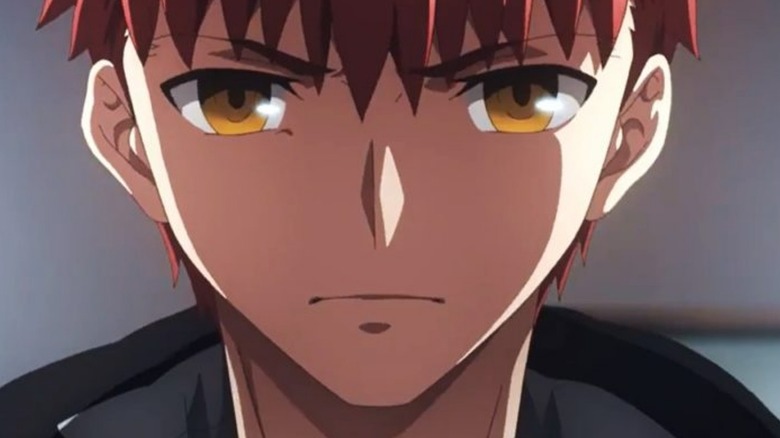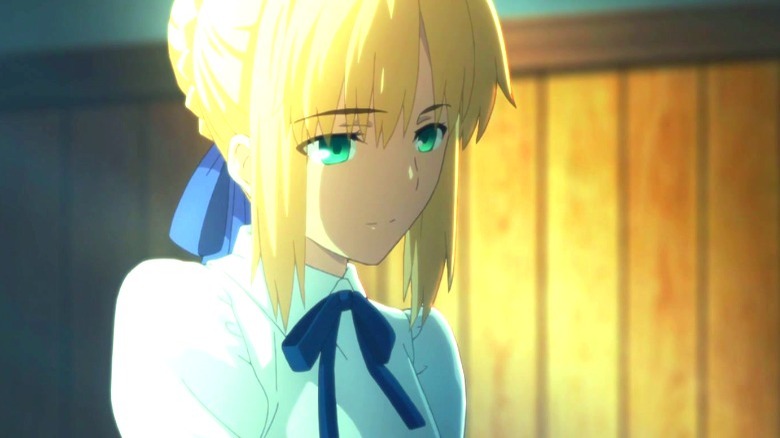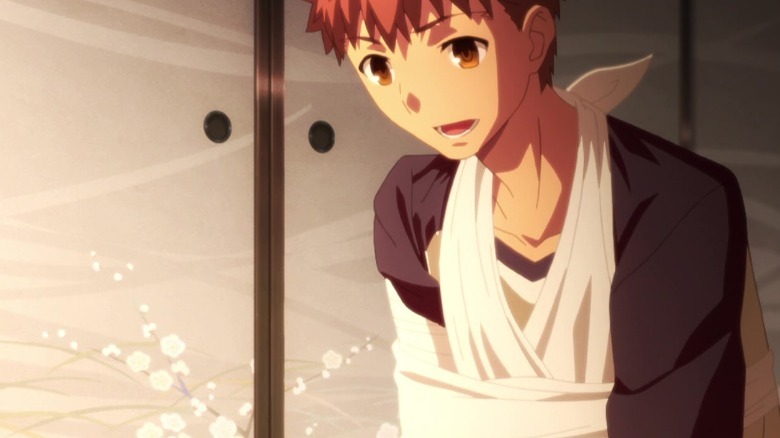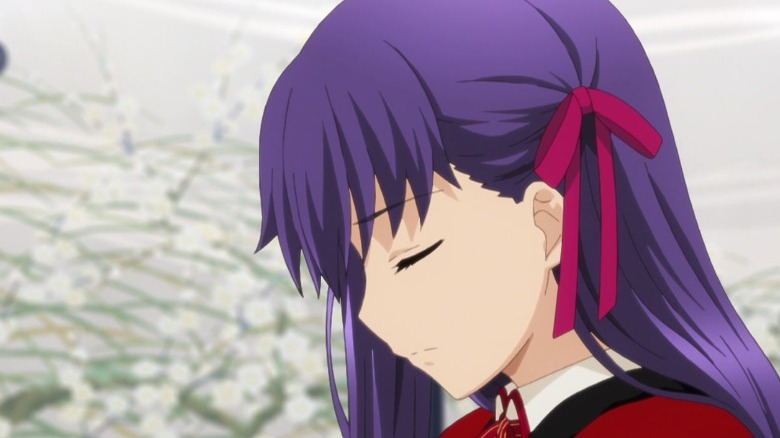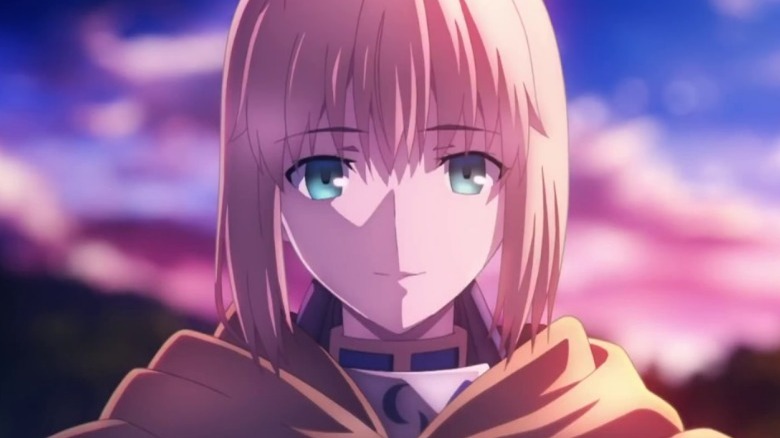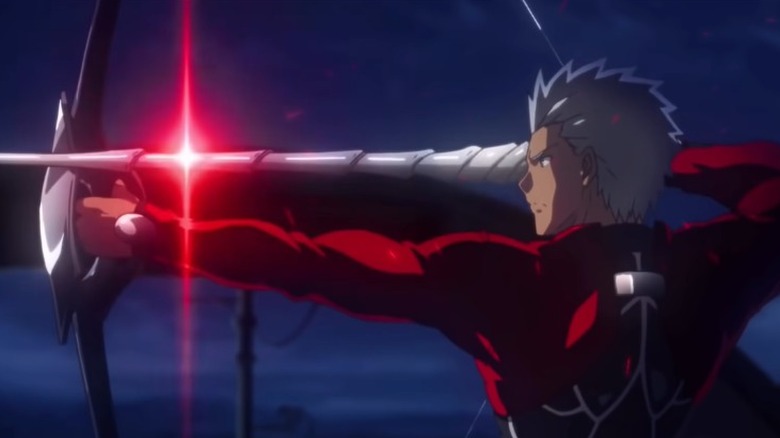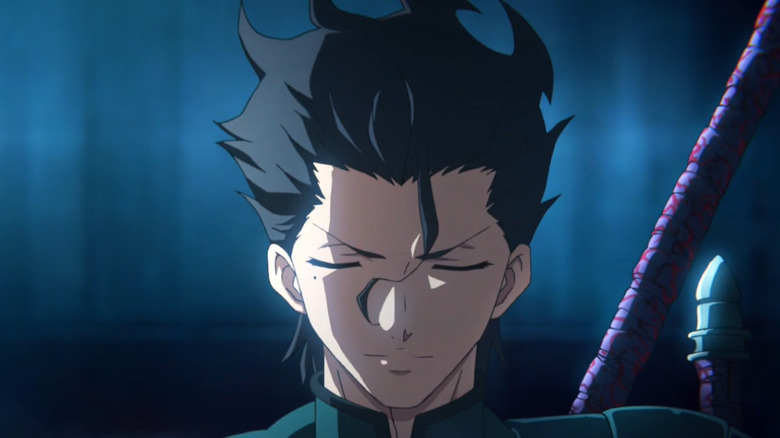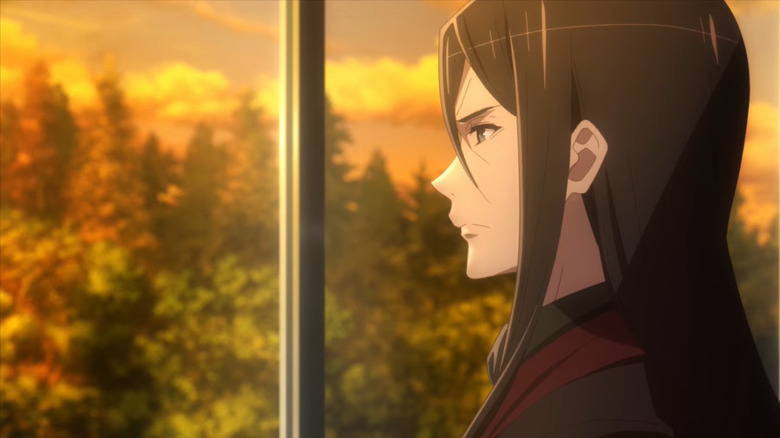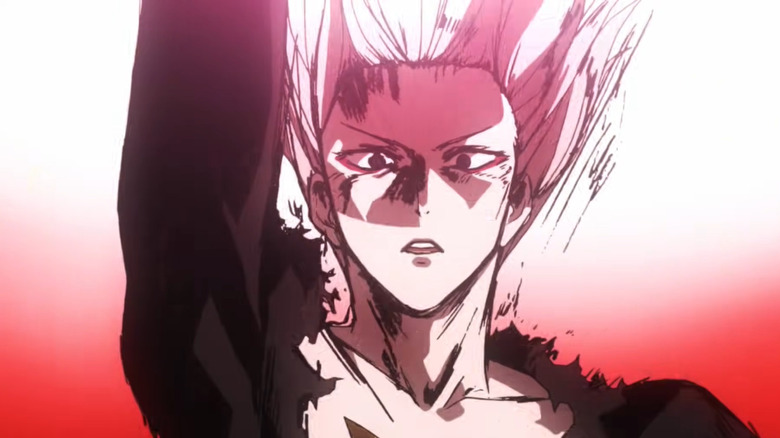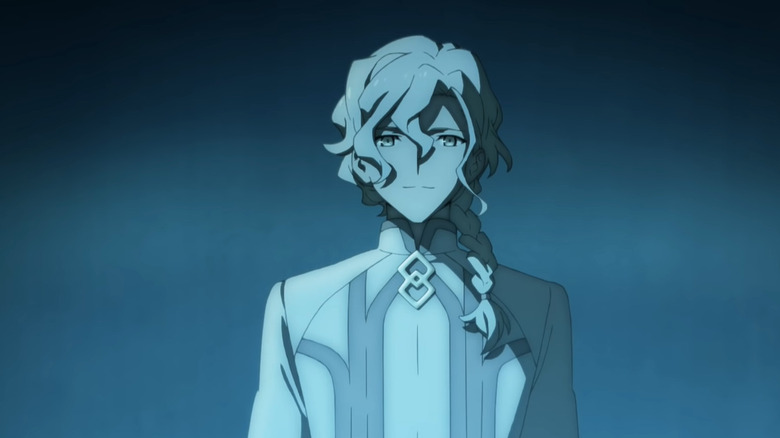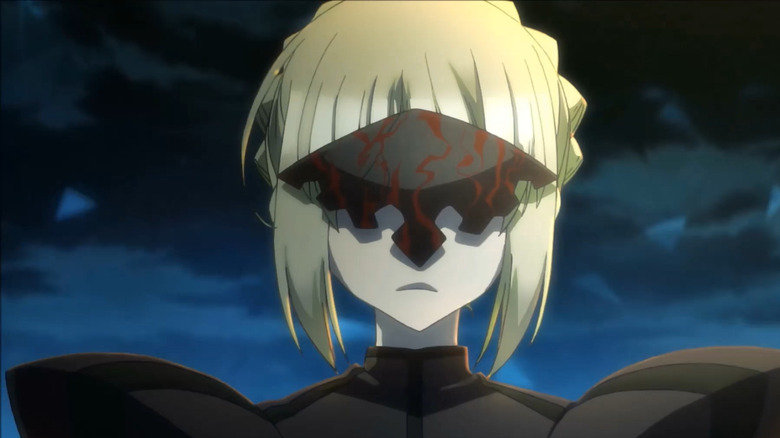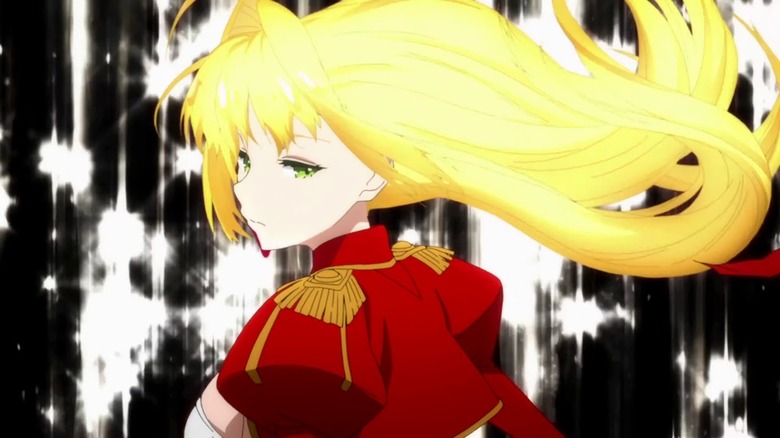This Is The Correct Order In Which To Watch Fate
"Fate" is a beloved anime, manga, and gaming franchise. With multiple timelines and highly developed "what if?" universes and continuities, part of the appeal is just how complex, layered, and bizarre the franchise can get.
It also means "Fate" is almost impossible to get into without proper guidance since almost any story in the "Fate" multiverse splits off from the continuity eventually. The complexity of the series' production also means you may need a guide to the best places to watch every episode.
Overall, the timeline can be understood as a series of six Holy Grail Wars, with different shows focused on (or splitting off from) a given Holy Grail War. The central "Fate/stay night" continuity is about the Fifth Holy Grail War, and the prequel "Fate/Zero" is about the Fourth Holy Grail War. "Fate/kaleid liner Prisma Illya," on the other hand, splits off before the Third Holy Grail War.
So what's a Holy Grail War? The battle royale at the heart of the "Fate" franchise, a Holy Grail War pits seven Masters, or magi, against each other for the wish-granting Holy Grail. They fight by using Servants, or summoned heroes from history and myth, that they bond with. Each series in the "Fate" franchise is about the goings-on during one of these wars, along various timelines that sometimes even interconnect — here is the correct order to watch each one.
Fate/stay night: Unlimited Blade Works
There are three routes in the original "Fate/stay night" storyline, which follow protagonist Shirou as he interacts with three different heroines during the Fifth Holy Grail War, and each of these has been adapted differently. The first story released was "Fate/stay night," an anime by Studio Deen that follows Shirou's interactions with Saber, the female King Arthur. Then there's "Unlimited Blade Works," the story of Shirou's teamup with Rin Tohsaka, which is a two-season anime. Finally, the "Heaven's Feel" trilogy of films explores the final route, where he fights to protect his friend Sakura.
In our watch order, we'll start with "Unlimited Blade Works" and "Heaven's Feel" before finishing up the trilogy with the original series and then move on to the major offshoots. This will give you the most even and understandable perspective on the worlds and universes of "Fate."
In "Unlimited Blade Works," Shirou and Saber team up with Rin Tohsaka to survive the Holy Grail War. It's a great ten-hour introduction to the themes and rules of the story and prepares you for the darker "Heaven's Feel" films without getting bogged down in their own continuity. Over the course of the series, "Unlimited Blade Works" examines the Reality Marble of Shirou Emiya and acts as his Noble Phantasm, a kind of powerup for Servants. The stronger Shirou becomes in his magic, the closer he gets to this true heroic state.
Note that the "Unlimited Blade Works" movie, also known as "Sunny Day," is an original video animation (OVA) released by Studio Deen after their "Fate/stay night" series and isn't really necessary to enjoy or understand the franchise. Here, we're talking about just the Ufotable anime "Unlimited Blade Works."
Fate/stay night: Heaven's Feel I. presage flower
Ten years after the Fourth Holy Grail War in which his father fought, Shirou Emiya is pulled into the Fifth — but there's something off about this latest War, and nothing is what it seems to be in Fuyuki City.
Shirou's Servant Saber and classmate Rin Tohsaka, the central figures of "Fate/stay night" and "Unlimited Blade Works," respectively, help Shirou protect his friend Sakura Matou, who is the main heroine of the third route, "Fate/Heaven's Feel." This acclaimed trilogy of movies was called "the best 'Fate' anime so far" by Anime News Network upon its release.
By viewing the "Heaven's Feel" trilogy after "Unlimited Blade Works," you can see the development of Shirou and his magic journey from beginning to end. It's a complicated story that grows richer the more you know about what's going on behind the scenes, exploring each route of the main continuity. Tiny divergences in each version of the story extrapolate into very different endings and meanings, just as in the manga.
"Fate/stay night: Heaven's Feel I. presage flower" sets a new, darker tone for the story that is carried through the next two movies. People are getting murdered and a strange creature is randomly attacking from the shadows, but that's just the beginning of what's gone wrong with this particular Holy Grail War.
Fate/stay night: Heaven's Feel II. lost butterfly
Shirou may have lost the fight — and his Servant, Saber — but nothing will stop him from protecting Sakura, who now seems to be falling ill. The mysterious creature continues its killing spree, and a surprising new Master enters the game: Sakura Matou herself!
In "Fate/stay night: Heaven's Feel II. lost butterfly" we learn that the distortions in this strange Holy Grail War are coming from the machinations of a man named Zouken Matou, one of the founding fathers of the Holy Grail War system. His serial killing Servant, True Assassin, is portrayed as a shadow covering the city as it continues taking down Masters and Servants alike.
Now, Shirou's not only fighting in the Holy Grail War and working to save Sakura — as in the other routes — but he needs to figure out and stop Zouken's plan as well. Without getting murdered, of course!
"Fate/stay night: Heaven's Feel II. lost butterfly" is a transitional chapter that moves "Fate/stay night: Heaven's Feel I. presage flower" forward while increasing the feeling of doom and darkness slowly overtaking the story. You really get to see how small changes create big impacts as the story goes on.
Fate/stay night: Heaven's Feel III. spring song
In "Fate/stay night: Heaven's Feel III. spring song" (2020), Shirou must confront not just his own sanity and safety, but the corruption now threatens his friends, has taken his Servant, and taints the Holy Grail itself. This finale is a great way to tie up your initial viewing of the second and third routes.
Thanks to the shadow influence, Sakura threatens to bring forth an old and terrible Servant called Angra Mainyu, who was once summoned by Illya's family. It takes the powers of Rin and Illya combined to get to the heart of the matter, which is the awesome true purpose of the Holy Grail. Shirou is joined in his journey this time by the priest Kirei and fellow mage Illya, with the help of Sakura's own Servant, as they attempt to end the Holy Grail Wars once and for all.
Once you're done with "Fate/stay night: Heaven's Feel III. spring song," it's time to move on to the longest series, "Fate/stay night." This is called the first route in the manga, but it's the last one we'll be taking in the main anime continuity.
Fate/stay night
"Fate/stay night" is the classic 2006 anime series from Studio Deen that started it all. The original visual novel for "Fate/stay night" has no official English translation. It was required before you could proceed through "Unlimited Blade Works" and "Heaven's Feel." Visual novels are a bit like video games or stories you can play but experience mostly by reading them.
Here, Shirou's experience of the Fifth Holy Grail War is centered on his relationship with his Servant, Saber. She is the summoned form of King Arthur that he uses to fight in the battle royale for the Grail. In each episode, Shirou and his Servants face off against other Masters and learn more of the secrets behind the Holy Grail War.
While this was the first story released in the franchise, it's best viewed last in the base trilogy sequence as you're learning about the world of "Fate." By now, you know the basic rules of the story and the Holy Grail Wars, and you can follow Shirou's development — and his desire to become a paragon of justice — in detail.
"Fate/hollow ataraxia" is a visual novel sequel set six months after "stay night," but there's no official English adaptation or anime yet.
Fate/Zero
"Fate/Zero," which was released in 2011, falls chronologically ten years before "Fate/stay night," but you should watch it only once you've finished "Fate/stay night" as it contains spoilers for the earlier series. It follows the fathers of our main "Fate/stay night" characters, but that's not the whole focus of the series. It's really about what happens after several coincidences and schemes combine to make the Fourth Holy Grail War as messy as anything we've seen yet.
In the Fourth Holy Grail War, there are the usual seven Masters, many of whom are the usual representatives of the founding families. Kiritsugu Emiya, Shirou's eventual father, is enlisted by the Einzbern family after they lose all the previous Holy Grail Wars. There's Tokiomi Tohsaka, Rin's father and the scion of the Tohsakas, and Kariya Matou of the Matou, who is fighting to save Sakura Matou. There's also Kirie Kotomine, the priest antihero from "Fate/stay night," who was supposed to be in charge of the War. Finally, the series features two Masters from the main magical authority, the Clocktower — and finally, a random serial killer is thrown into the mix!
Much like Shirou's experience with the Fifth Holy Grail War, these all complicate matters far beyond what Kiritsugu and the others are expecting. If you enjoy the world of "Fate" but would prefer it with a little less of the high school high jinx, "Fate/Zero" may be your best option. Dark, fascinating, and full of secrets, "Fate/Zero" is a worthy prequel that expands the world of the show in brilliant and often terrifying ways.
Lord El-Melloi II's Case Files: Rail Zeppelin Grace note
"Lord El-Melloi II's Case Files: Rail Zeppelin Grace note" is an anime that takes place between "Fate/Zero" and "Fate/stay night." Specifically, it occurs ten years after the Fourth Holy Grail War events of "Fate/Zero" and two months before the events of "Fate/stay night" and revolves around the Clocktower, which is the principal educational and magical authority that administrates the magi and their Holy Grail Wars.
Ten years after the Fourth Holy Grail War, Lord El-Melloi II — formerly the Master known as Waver Velvet — is a teacher at the Clocktower who is bound to obey the orders of Reines, the younger sister of the old lord of House El-Melloi. Eventually, she will take over and rule, but for now, Waver serves as a kind of regent and must follow her instructions.
It's a complicated game of loyalties as Reines and the Mages' Association send Waver and his apprentice Gray to solve more and more complex mysteries, which eventually lead straight to the secrets of Reines and the Clocktower itself. These truths about the Clocktower, the world of "Fate," and the nature of Servants help inform the meaning of the main world stories of Shirou.
Fate/Apocrypha
The word apocrypha can sometimes be taken to mean unnecessary — but most fans would agree that the story in "Fate/Apocrypha" is anything but. While there are definitely some "Fate/stay night" filler episodes you can skip if you like, "Fate/Apocrypha" is well worth exploring.
The story of "Fate/Apocrypha" takes place in a parallel Europe that splits off after the Third Holy Grail War and was first told in a series of light novels and then an ongoing manga. This anime series consists of a single season of 24 episodes, each about 25 minutes long, which adds almost ten hours in total, not counting recaps and specials.
Here, the Yggdmillennia family takes the Grail off to Romania and keeps it a secret for decades. When they start a new Holy Grail War among themselves, the Grail summons a new set of seven Masters and Servants to oppose them. "Fate/Apocrypha" follows these two resulting European factions, the Red and Black teams of Masters, as they battle for the Grail and the immense power it contains. The series contains a good mix of fighting, worldbuilding, and genuine discoveries.
Fate/Grand Order
"Fate/Grand Order" is a follow-up series, role-playing game (RPG), and series of movies. This timeline is set in a world where there was no First Holy Grail War, and there are 13 classes of Servants instead of seven.
"Fate/Grand Order – First Order" and "Fate/Grand Order – Absolute Demonic Front: Babylonia" revolve around the creation and activities of the Grand Order. This is the secretive group of magi attempting to repair time that's been broken by various Singularities caused by Holy Grails throughout time and space. In "Fate/Grand Order – Absolute Demonic Front: Babylonia" Master Ritsuka Fujimaru and his Servant Mash Kyrielight travel back in time to Mesopotamia to solve the mystery of the seventh Singularity.
"Fate/Grand Order: Divine Realm of the Round Table: Camelot" and "Fate/Grand Order: Divine Realm Of The Round Table: Camelot Paladin; Agateram" together tell the three-hour story of the Camelot Singularity and how it is resolved.
If you love the world of "Fate" but get tired of the classic Master and Servant Holy Grail War battle format, these various Singularity stories are a great way to explore. You still get the fighting and the expansive, layered world, but with more storytelling surprises.
Fate/kaleid liner Prisma Illya
"Fate/kaleid liner Prisma Illya" is an alternate universe spin-off that separates from the "Fate/Stay Night" timeline before even the First Holy Grail War — which puts it very far off from the main continuity. It recontextualizes many heroes and locations, sometimes in unexpected ways.
Originally a manga, there have been four anime seasons of "Fate/kaleid liner Prisma Illya" so far and a Shirou-centric prequel movie called "Fate/kaleid liner Prisma Illya: Oath Under Snow." The story starts with Rin Tohsaka and Luvia Edelfelt from "Fate/stay night," who can become magical girls thanks to sentient Kaleidosticks called Ruby and Sapphire. They use the powers they receive to track down seven Class Cards, which are corrupted versions of the Servants from the original "Fate/stay night."
Eventually, the Kaleidosticks choose new holders in Illya and Shirou's sister Miyu, also from "Fate/stay night." From there, the main story of "Fate/kaleid liner Prisma Illya" follows their adventures with Rin's help as Illya's sister Chloe gets involved, the girls learn to use the Class Cards in combat, and they eventually locate the eighth Class Card, Gilgamesh. Once he escapes from the mirror-world of the Class Cards, he ritually separates into a child version of himself and a giant monster that has access to most of Gilgamesh's skills and a fervant desire to win the Holy Grail War.
If you are enjoying the main world stories or have found your way into "Fate" through one of the other storylines, this one comes highly recommended. Everything's just a little off from how you remember it, in classic continuity, but the girls and magic at the heart of "Fate/kaleid liner Prisma Illya" are fascinating and fun to spend time with.
Fate/Extra
The "Fate/Extra" universe of anime, games, and manga all split off from the original plot at the Third Holy Grail War when a pre-human computer on the Moon, called the Moon Cell Automaton, builds a virtual high school in 2030. In the Holy Grail War it holds, there are now 128 Masters rather than just seven! The Moon Cell Automaton's plans and goals become clearer as the battle royale narrows down the playing field.
"Fate/Extra Last Encore" is composed of the ten-episode anime arc "Oblitus Copernican Theory" that takes place in this side universe, 1000 years after the Holy Grail War begins. It's followed by a three-episode arc called "Illustrias Geocentric Theory" that continues the story.
The rest of the story of this timeline is explored through video games and visual novels as different Servants and Masters play out in various combinations. Like "Apocrypha," it's a fan favorite of the out-of-continuity storylines and a great way to finish up your viewing of the main stories in "Fate."
Now you can go back and fill in any blanks, playing and reading the games and novels, for the full experience. But rest assured you've seen the best selection of "Fate" anime adaptations — and in the perfect sequence. From "Unlimited Blade Works" to "Heaven's Feel" to "Fate/stay night," you get to experience Shirou's journey three times before you learn about the Fourth Holy Grail War in "Fate/Zero." Following that, you can take off on the whole new adventures of "Fate/Apocrypha" and "Fate/Extra," revel in the worldbuilding of "Fate/Grand Order," and come along for the delightful "Fate/kaleid liner Prisma Illya."
